A Three-Terminal Si-Ge Avalanche Photodiode with a Breakdown Voltage of 6.8 V and a Gain Bandwidth Product of 1377 GHz
Abstract
1. Introduction
2. APD Design
3. Simulation Results
4. Discussion
5. Conclusions
Author Contributions
Funding
Data Availability Statement
Conflicts of Interest
References
- Xue, J.; Wang, B.; Chen, Y.; Chen, S.; Wu, J.; Cheng, C.; Bao, S.; Qi, N.; Zhang, W. A 4 × 112 Gb/s Ultra-Compact Polarization-Insensitive Silicon Photonics WDM Receiver with CMOS TIA for Co-Packaged Optics and Optical I/O. J. Light. Technol. 2024, 12, 6028–6035. [Google Scholar] [CrossRef]
- Cheng, C.; Xue, J.; Bao, S.; Liu, Q.; Zhang, W.; Wang, B. A 112 Gbps Silicon-Germanium Avalanche Photodiode with Ultra-High Gain-Bandwidth Product. In Proceedings of the Optical Fiber Communications Conference and Exhibition (OFC), San Francisco, CA, USA, 30 March–3 April 2025. [Google Scholar]
- Timurdogan, E.; Su, Z.; Shiue, R.-J.; Byrd, M.J.; Poulton, C.V.; Jabon, K.; DeRose, C.; Moss, B.R.; Hosseini, E.S.; Duzevik, I.; et al. 400g silicon photonics integrated circuit transceiver chipsets for cpo, obo, and pluggable modules. In Proceedings of the 2020 Optical Fiber Communications Conference and Exhibition (OFC), San Diego, CA, USA, 8–12 March 2020. [Google Scholar]
- Smit, M.; Leijtens, X.; Ambrosius, H.; Bente, E.; Van Der Tol, J.; Smalbrugge, B.; De Vries, T.; Geluk, E.-J.; Bolk, J.; Van Veldhoven, R.; et al. An introduction to InP-based generic integration technology. Semicond. Sci. Technol. 2014, 29, 083001. [Google Scholar] [CrossRef]
- Chen, G.; Goyvaerts, J.; Kumari, S.; Van Kerrebrouck, J.; Muneeb, M.; Uvin, S.; Yu, Y.; Roelkens, G. Integration of high-speed GaAs metalsemiconductor-metal photodetectors by means of transfer printing for 850 nm wavelength photonic interposers. Opt. Express 2018, 26, 6351–6359. [Google Scholar] [CrossRef]
- Zhou, D.; Sun, C.; Lai, Y.; Yu, Y.; Zhang, X. Integrated silicon multifunctional mode-division multiplexing system. Opt. Express 2019, 27, 10798–10805. [Google Scholar] [CrossRef] [PubMed]
- Zhou, D.; Yu, Y.; Zhang, X. Parallel radio-frequency signal-processing unit based on mode multiplexed photonic integrated circuit. Opt. Express 2018, 26, 20544–20549. [Google Scholar] [CrossRef] [PubMed]
- Dong, P.; Xie, C.; Buhl, L.L. Monolithic polarization diversity coherent receiver based on 120-degree optical hybrids on silicon. Opt. Express 2014, 22, 2119–2125. [Google Scholar] [CrossRef] [PubMed]
- Calafiore, G.; Koshelev, A.; Dhuey, S.; Goltsov, A.; Sasorov, P.; Babin, S.; Yankov, V.; Cabrini, S.; Peroz, C. Holographic planar lightwave circuit for on-chip spectroscopy. Light Sci. Appl. 2014, 3, e203. [Google Scholar] [CrossRef]
- Rao, A.; Fathpour, S. Compact Lithium Niobate Electrooptic Modulators. IEEE J. Sel. Top. Quant. 2018, 24, 1–14. [Google Scholar] [CrossRef]
- Bowers, J.E.; Liu, A.Y. A Comparison of Four Approaches to Photonic Integration. In Proceedings of the Optical Fiber Communication Conference and Exhibition (OFC), Los Angeles, CA, USA, 19–23 March 2017. [Google Scholar]
- Xue, J.; Wu, J.; Cheng, C.; Zhang, W.; Wang, B. A 4 × 112Gbps Compact Polarization-Insensitive Silicon Photonic WDM Receiver. In Proceedings of the Optical Fiber Communications Conference and Exhibition (OFC), San Diego, CA, USA, 24–28 March 2024. [Google Scholar]
- Caut, A.; Shekhawat, V.; Torres-Company, V.; Karlsson, M. Polarization-Insensitive Silicon Nitride Photonic Receiver at 1 μm for Optical Interconnects. IEEE Photonics J. 2024, 16, 1–7. [Google Scholar]
- Mikkelsen, J.C.; Bois, A.; Lordello, T.; Mahgerefteh, D.; Menezo, S.; Poon, J.K.S. Polarization-insensitive silicon nitride mach-zehnder lattice wavelength demultiplexers for CWDM in the O-band. Opt. Express 2018, 26, 30076–30084. [Google Scholar] [CrossRef]
- He, A.; Guo, X.; Wang, T.; Su, Y. Ultracompact fiber-to-chip metamaterial edge coupler. ACS Photonics 2021, 8, 3226–3233. [Google Scholar] [CrossRef]
- Sacher, W.D.; Mikkelsen, J.C.; Dumais, P.; Jiang, J.; Goodwill, D.; Luo, X.; Huang, Y.; Yang, Y.; Bois, A.; Lo, P.G.-Q.; et al. Tri-layer silicon nitride-on-silicon photonic platform for ultra-low-loss crossings and interlayer transitions. Opt. Express 2017, 25, 30862–30875. [Google Scholar] [CrossRef]
- Srinivasan, S.A.; Berciano, M.; De Heyn, P.; Lardenois, S.; Pantouvaki, M.; Van Campenhout, J. 27 Ghz silicon-contacted waveguide-coupled Ge/Si Avalanche Photodiode. J. Light. Technol. 2020, 38, 3044–3050. [Google Scholar] [CrossRef]
- Wang, B.; Huang, Z.; Yuan, Y.; Liang, D.; Zeng, X.; Fiorentino, M.; Beausoleil, R.G. 64 gb/s low-voltage waveguide si-ge avalanche photodiodes with distributed bragg reflectors. Photonics Res. 2020, 8, 1118–1123. [Google Scholar] [CrossRef]
- Cao, H.; Xiang, Y.; Sun, W.; Xie, J.; Guo, J.; Dai, D. Waveguide Ge/Si Avalanche Photodetector with Ultra-High Gain-Bandwidth Product of 1440GHz. In Proceedings of the 2023 Asia Communications and Photonics Conference/2023 International Photonics and Optoelectronics Meetings (ACP/POEM), Wuhan, China, 4–7 November 2023. [Google Scholar]
- Xiang, Y.; Cao, H.; Liu, C.; Guo, J.; Dai, D. High speed waveguide ge/si avalanche photodiode with a gain-bandwidth product of 615 GHz. Optica 2022, 9, 762–769. [Google Scholar] [CrossRef]
- Wei, Z.; Zhang, Q.; Huang, Q.; Fang, S.; Jiang, X.; Zhang, S.; Shi, Y.; Wang, Y.; Zhou, G.; Yang, J.; et al. Ultrahigh gain-bandwidth product Ge/Si avalanche photodetector assisted by nonuniform electric field distribution. In Proceedings of the European Conference on Optical Communications (ECOC), Frankfurt, Germany, 22–26 September 2024. [Google Scholar]
- Kang, Y.; Liu, H.-D.; Morse, M.; Paniccia, M.J.; Zadka, M.; Litski, S.; Sarid, G.; Pauchard, A.; Kuo, Y.-H.; Chen, H.-W.; et al. Monolithic germanium/silicon avalanche photodiodes with 340 GHz gain–bandwidth product. Nat. Photonics 2009, 3, 59–63. [Google Scholar] [CrossRef]
- Wei, Z.; Zhang, Q.; Huang, Q.; Fang, S.; Jiang, X.; Zhang, S.; Shi, Y.; Wang, Y.; Zhou, G.; Yang, J.; et al. High-gain Ge/Si avalanche photodetector enhanced by distributed structure. In Proceedings of the Optical Fiber Communications Conference and Exposition (OFC), San Francisco, CA, USA, 30 March–3 April 2025. [Google Scholar]
- Tsiara, A.; Berciano, M.; Yudistira, D.; Loo, R.; Musibau, S.; Verheyen, P.; Ferraro, F.; Ban, Y.; Croes, K.; Van Campenhout, J. 50 Gbps vertical separate absorption charge multiplication Ge/Si avalanche waveguide photodetectors integrated in a 300-mm Si photonics platform. In Proceedings of the 49th European Conference on Optical Communications (ECOC), Glasgow, UK, 1–5 October 2023. [Google Scholar]
- Yuan, Y.; Huang, Z.; Wang, B.; Sorin, W.V.; Zeng, X.; Liang, D.; Fiorentino, M.; Campbell, J.C.; Beausoleil, R.G. 64 Gbps PAM4 Si-Ge Waveguide Avalanche Photodiodes With Excellent Temperature Stability. J. Light. Technol. 2020, 17, 4857–4866. [Google Scholar] [CrossRef]
- Zeng, X.; Huang, Z.; Wang, B.; Liang, D.; Fiorentino, M.; Beausoleil, R.G. Silicon–germanium avalanche photodiodes with direct control of electric field in charge multiplication region. Optica 2019, 6, 772–777. [Google Scholar] [CrossRef]
- Fernández-Hinestrosa, A.; Luque-González, J.M.; Cheben, P.; Schmid, J.H.; Sánchez-Postigo, A.; Wangüemert-Pérez, J.G.; Molina-Fernández, I.; Ortega-Moñux, A. Polarization-independent complex bragg grating filters on silicon nitride. Laser Photonics Rev. 2025, e02114. [Google Scholar] [CrossRef]
- Cheng, C.; Xue, J.; Yu, Z.; Wu, J.; Bao, S.; Wang, B. A High-Power Lateral p-i-n Silicon-Germanium Photodiode. In Proceedings of the 2024 Photonics &Electromagnetics Research Symposium (PIERS), Chengdu, China, 21–25 April 2024. [Google Scholar]
- Hu, X.; Wu, D.; Zhang, H.; Li, W.; Chen, D.; Wang, L.; Xiao, X.; Yu, S. High-speed and high-power germanium photodetector with a lateral silicon nitride waveguide. Photonics Res. 2021, 9, 749–756. [Google Scholar] [CrossRef]
- Shi, Y.; Li, X.; Chen, G.; Zou, M.; Cai, H.; Yu, Y.; Zhang, X. Avalanche photodiode with ultrahigh gain–bandwidth product of 1,033 GHz. Nat. Photon. 2024, 18, 610–616. [Google Scholar] [CrossRef]
- Sze, S.M.; Ng, K.K. Physics of Semiconductor Devices, 3rd ed.; John Wiley & Sons: Hoboken, NJ, USA, 2007. [Google Scholar]
- Huang, Z.; Li, C.; Liang, D.; Yu, K.; Santori, C.; Fiorentino, M.; Sorin, W.; Palermo, S.; Beausoleil, R.G. 25 Gbps low-voltage waveguide Si–Ge avalanche photodiode. Optica 2016, 3, 793–798. [Google Scholar] [CrossRef]
- Hu, X.; Zhang, H.; Wu, D.; Chen, D.; Wang, L.; Xiao, X.; Yu, S. High-performance germanium avalanche photodetector for 100 Gbit/s photonics receivers. Opt. Lett. 2021, 46, 3837–3840. [Google Scholar] [CrossRef]
- Huang, M.; Cai, P.; Li, S.; Hou, G.; Zhang, N.; Su, T.-I.; Hong, C.-Y.; Pan, D. 56GHz waveguide Ge/Si avalanche photodiode. In Proceedings of the Optical Fiber Communications Conference and Exposition (OFC), San Diego, CA, USA, 11–15 March 2018. [Google Scholar]
- Srinivasan, S.A.; Lambrecht, J.; Guermandi, D.; Lardenois, S.; Berciano, M.; Absil, P. 56 Gb/s NRZ O-Band hybrid BiCMOS-Silicon photonics receiver using Ge/si avalanche photodiode. J. Light. Technol. 2020, 39, 1409–1415. [Google Scholar] [CrossRef]
- Zhu, Y.; Liu, Z.; Niu, C.; Pang, Y.; Zhang, D.; Liu, X.; Zheng, J.; Zuo, Y.; Xue, H.; Cheng, B. High-speed and high-power germanium photodetector based on a trapezoidal absorber. Opt. Lett. 2022, 47, 3263–3266. [Google Scholar] [CrossRef]
- Yuan, Y.; Huang, Z.; Zeng, X.; Liang, D.; Sorin, W.V.; Fiorentino, M.; Beausoleil, R.G. High responsivity Si-Ge waveguide avalanche photodiodes enhanced by loop reflector. IEEE J. Sel. Top. Quantum Electron. 2022, 28, 1–8. [Google Scholar] [CrossRef]
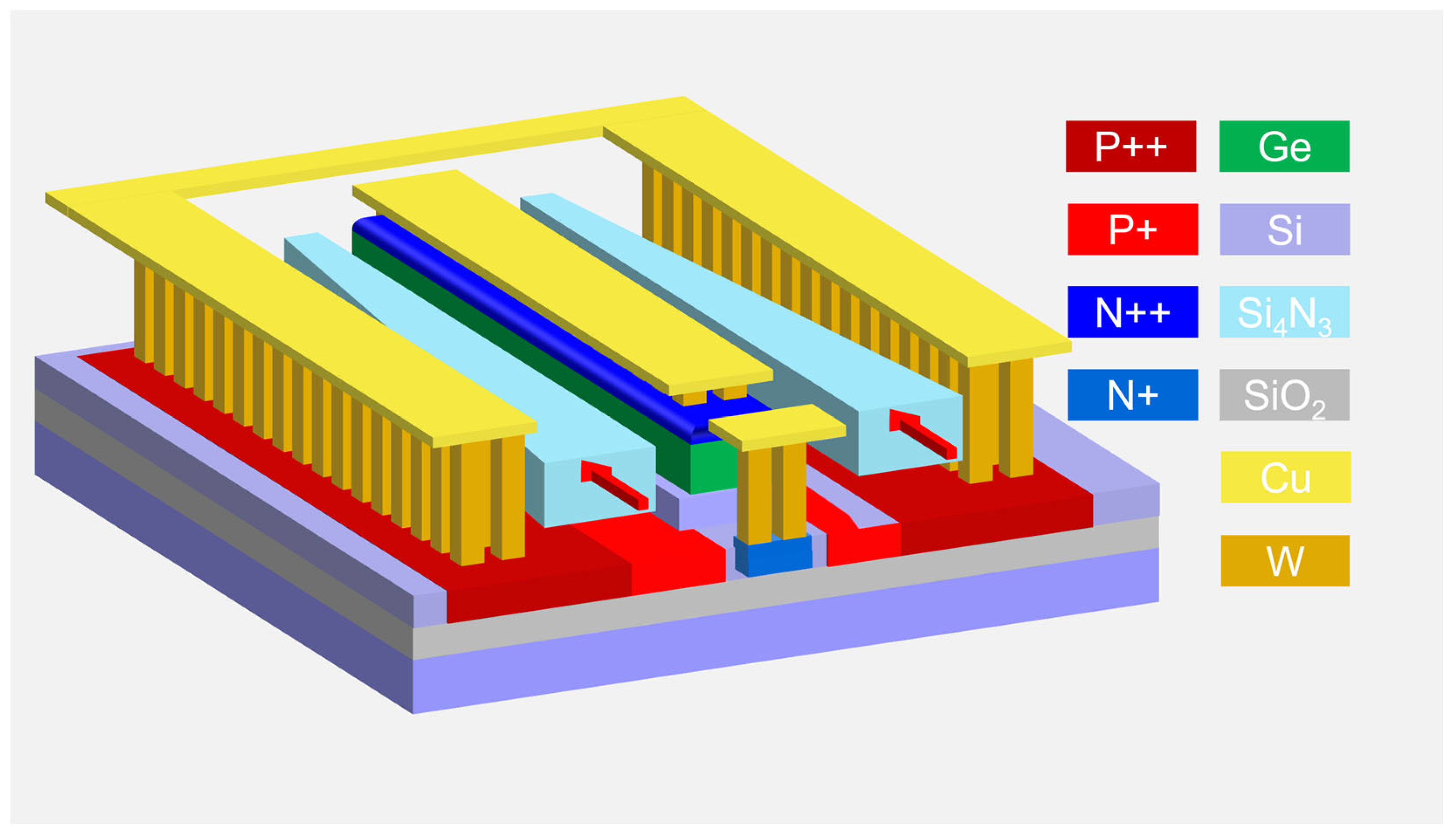

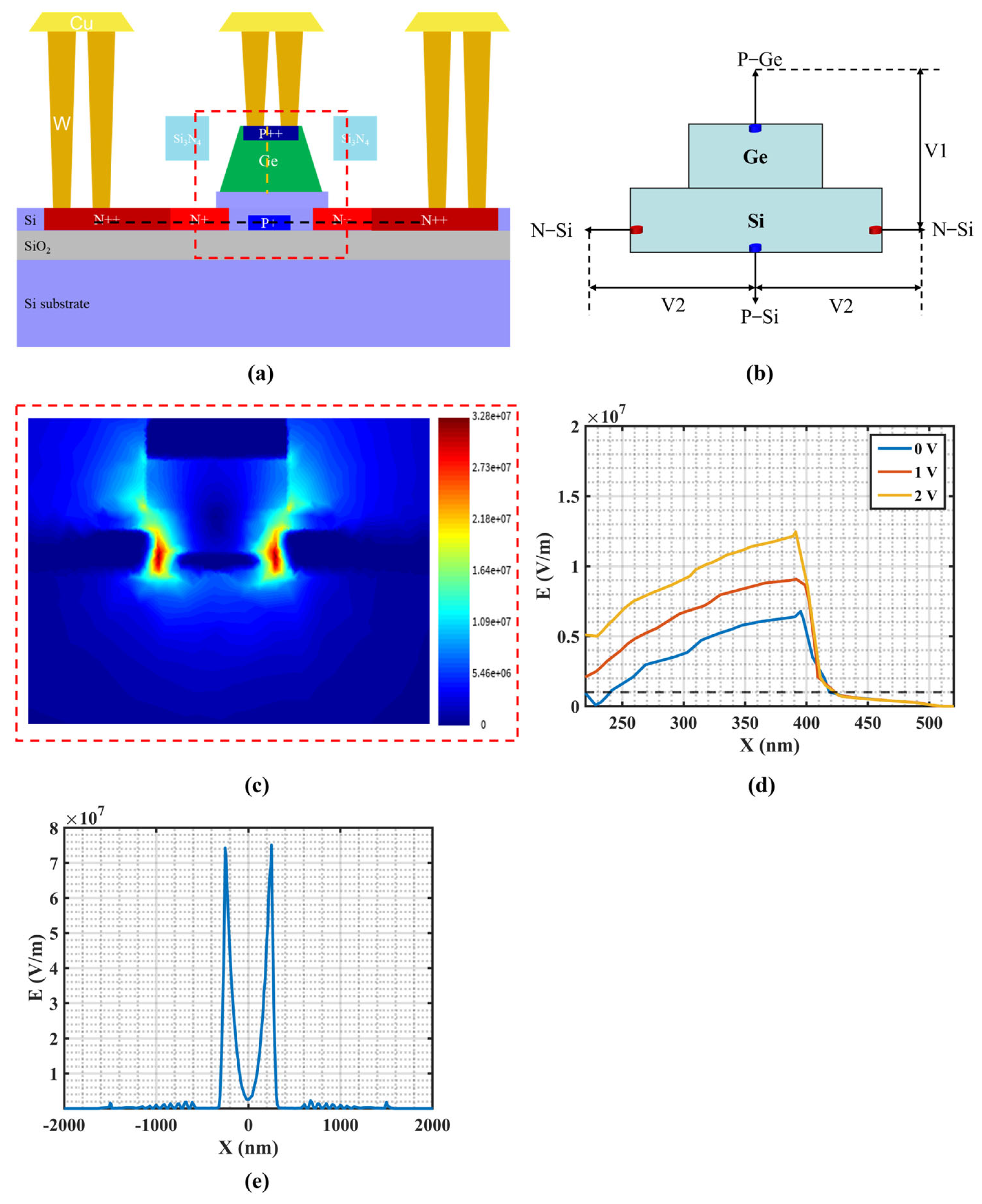
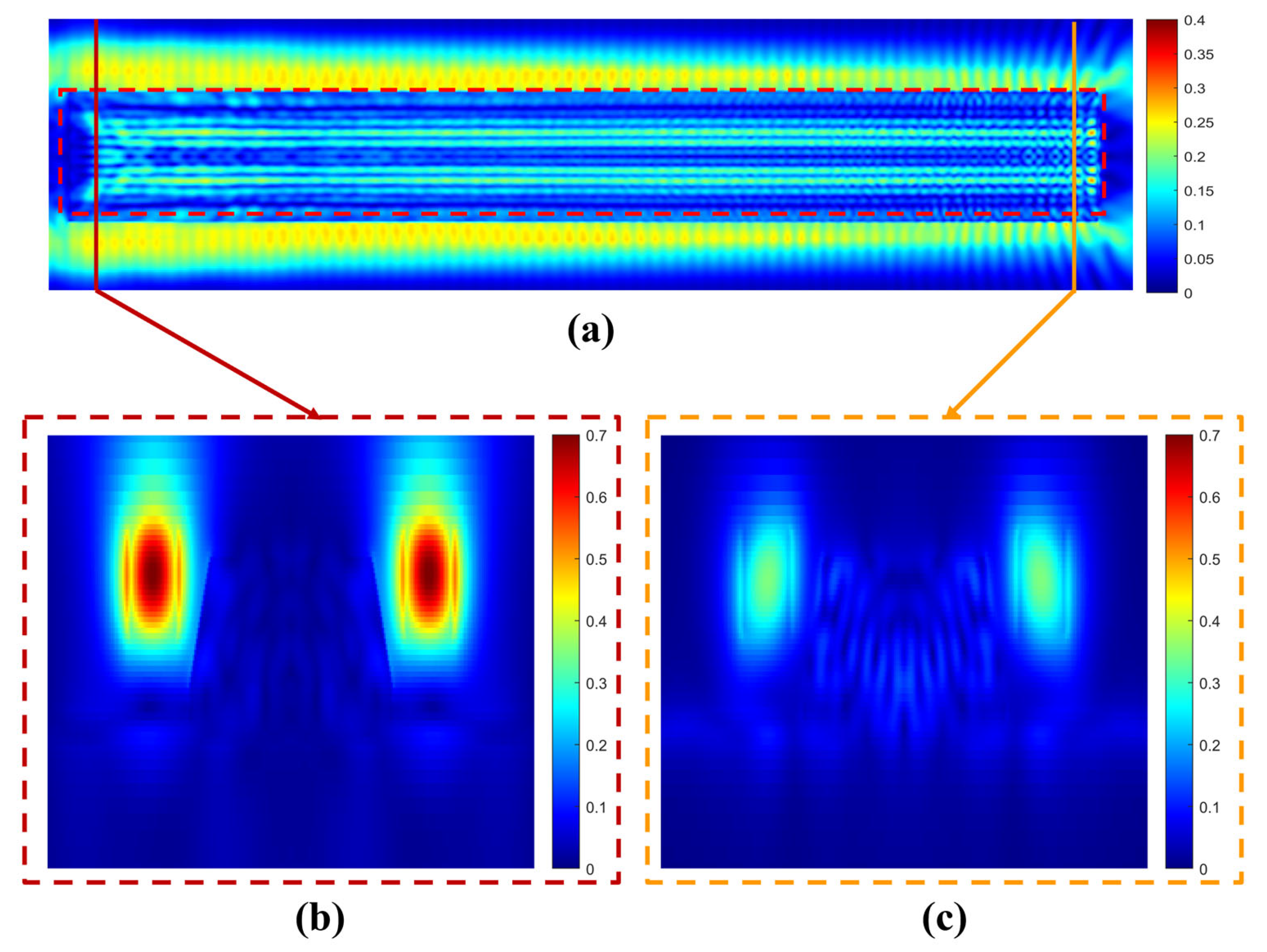
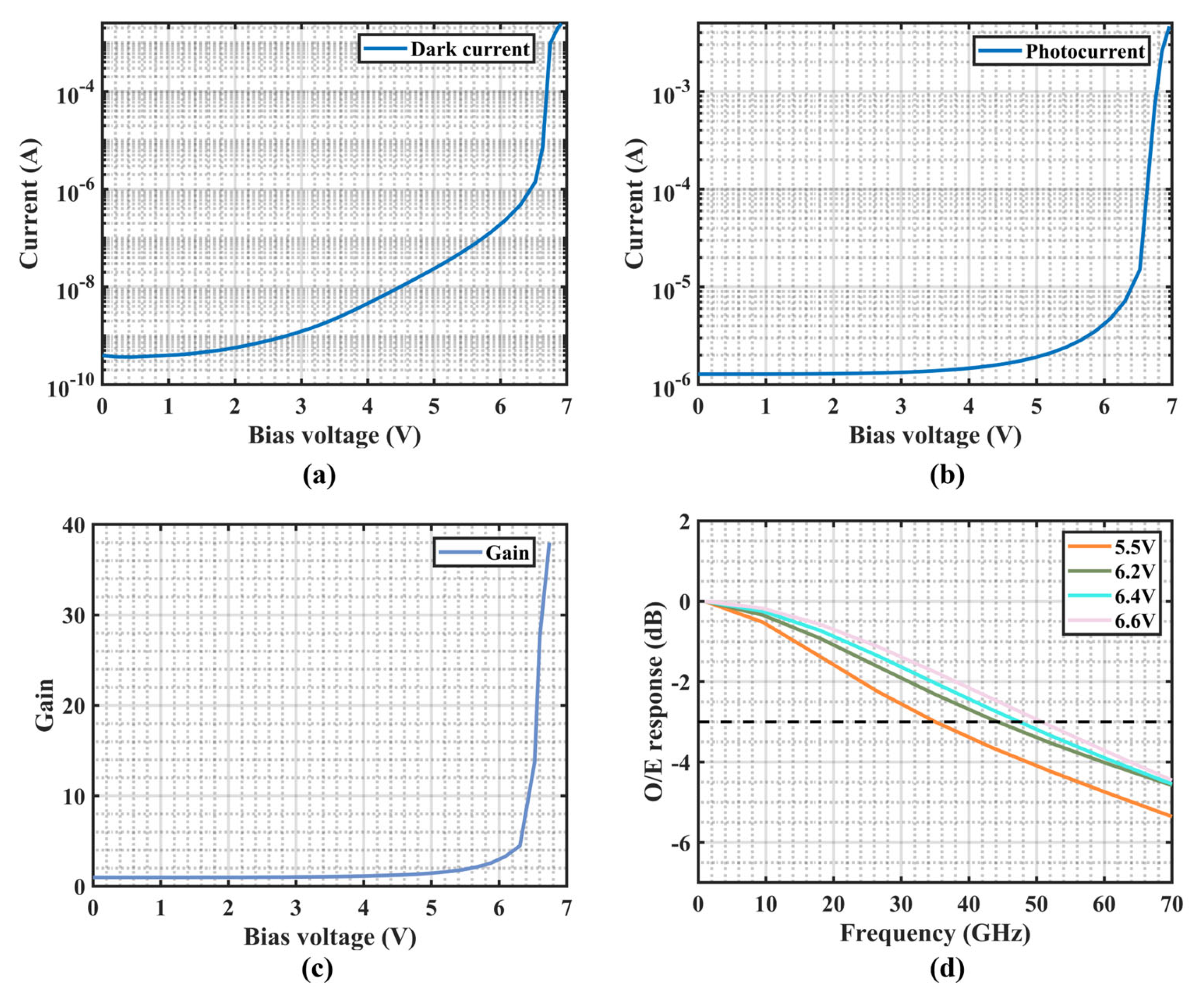
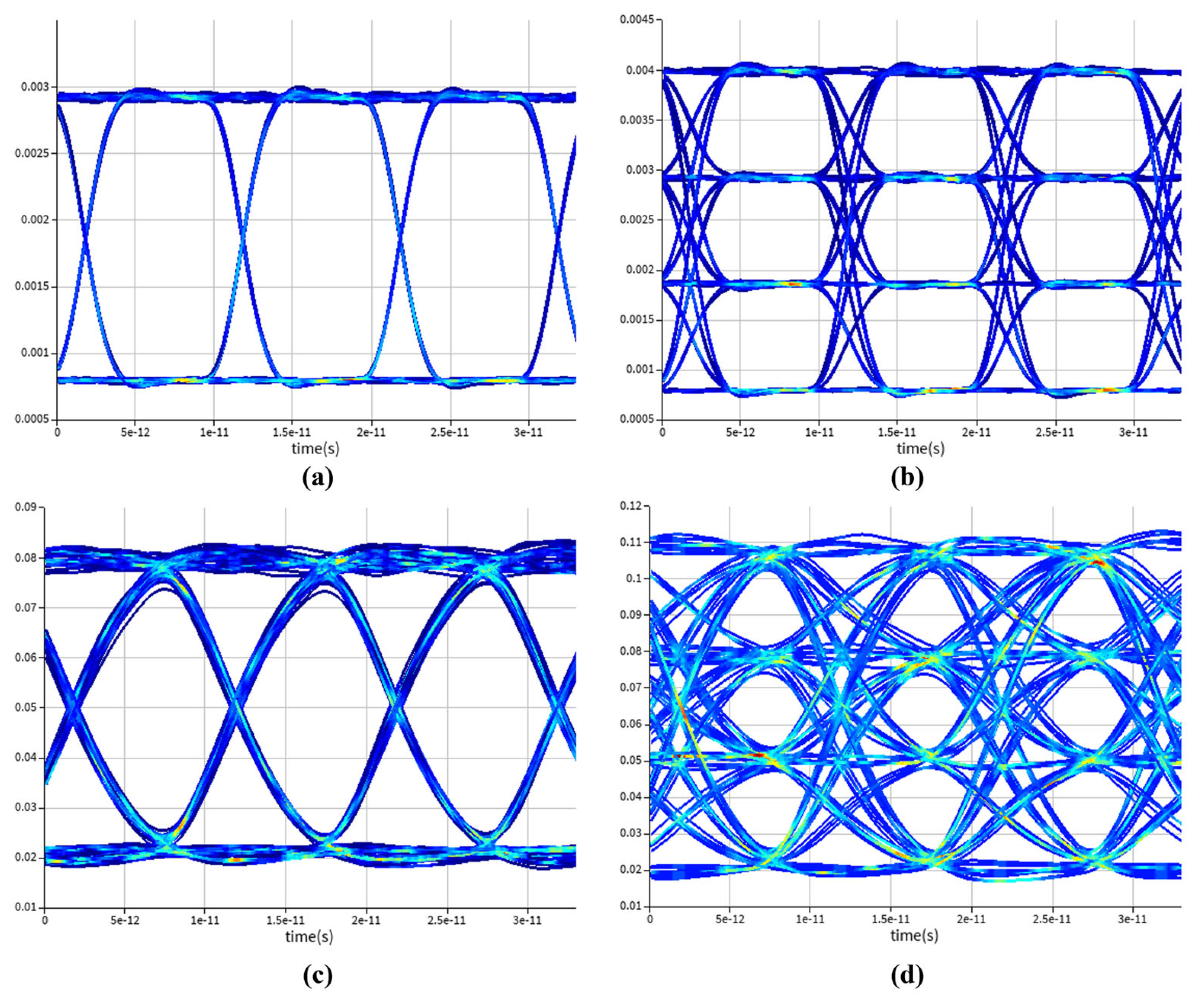
| Reference | Avalanche Region | λ (nm) | Vbias (V) | Id (μA) | Gain | BW (GHz) | GBP (GHz) | Bit Rate (Gbps) |
|---|---|---|---|---|---|---|---|---|
| [2] | Si | 1310 | −12.5 | ~8.4 | 244 | 29 | 7078 | 112 (PAM4) |
| [17] | SI | 1310 | −12 | ~100 | 11 | 27 | 300 | 50 (OOK) |
| [26] | Si | 1550 | −6 | ~10 | 15 | 18.9 | 284 | 35 (OOK) |
| [34] | Si | 1310 | −17 | ~0.12 | - | 56 | - | - |
| [35] | Si | 1310 | −11 | ~3.5 | 8 | 17 | 136 | 56 (OOK) |
| This Work * | Si | 1310 | −6.6 | 7.31 | 27 | 51 | 1377 | 200 (PAM4) |
Disclaimer/Publisher’s Note: The statements, opinions and data contained in all publications are solely those of the individual author(s) and contributor(s) and not of MDPI and/or the editor(s). MDPI and/or the editor(s) disclaim responsibility for any injury to people or property resulting from any ideas, methods, instructions or products referred to in the content. |
© 2025 by the authors. Licensee MDPI, Basel, Switzerland. This article is an open access article distributed under the terms and conditions of the Creative Commons Attribution (CC BY) license (https://creativecommons.org/licenses/by/4.0/).
Share and Cite
Cheng, C.; Xue, J.; Yu, X.; Mu, J.; Wang, B. A Three-Terminal Si-Ge Avalanche Photodiode with a Breakdown Voltage of 6.8 V and a Gain Bandwidth Product of 1377 GHz. Micromachines 2025, 16, 1222. https://doi.org/10.3390/mi16111222
Cheng C, Xue J, Yu X, Mu J, Wang B. A Three-Terminal Si-Ge Avalanche Photodiode with a Breakdown Voltage of 6.8 V and a Gain Bandwidth Product of 1377 GHz. Micromachines. 2025; 16(11):1222. https://doi.org/10.3390/mi16111222
Chicago/Turabian StyleCheng, Chao, Jintao Xue, Xishan Yu, Jifang Mu, and Binhao Wang. 2025. "A Three-Terminal Si-Ge Avalanche Photodiode with a Breakdown Voltage of 6.8 V and a Gain Bandwidth Product of 1377 GHz" Micromachines 16, no. 11: 1222. https://doi.org/10.3390/mi16111222
APA StyleCheng, C., Xue, J., Yu, X., Mu, J., & Wang, B. (2025). A Three-Terminal Si-Ge Avalanche Photodiode with a Breakdown Voltage of 6.8 V and a Gain Bandwidth Product of 1377 GHz. Micromachines, 16(11), 1222. https://doi.org/10.3390/mi16111222







